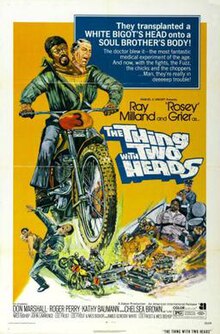Plot
Dr. Maxwell Kirshner arrives at a mansion in a wheelchair; once inside, Kirshner asks if his experiment has been a success, and is told by an orderly that it has been. He is taken to the basement, where the experiment is in fact a two-headed gorilla that Dr. Kirshner has created. The experiment is to determine whether two heads can survive on a single body. Kirshner has done this because he has not much longer to live and wants to transplant his still living head from his lifeless body onto a donor so that he may continue living and continue working as the world's most successful surgeon.
Kirshner returns to his hospital institute to oversee an operation performed by his friend and associate doctor, Phillip Desmond. Kirshner returns to the basement and his two headed gorilla to remove one of the heads from its body. Kirshner orders his assistants to sedate his creature, but plans go awry when the creature is upset about the needle and knocks him out of his wheelchair, hurting him badly. The creature runs away and into a supermarket, chased by the assistants, where he is caught.
Kirshner hires a new doctor, Fred Williams, to help Desmond but when he discovers that Dr. Williams is African-American he tells Williams that he is no longer needed, to which Williams takes great offense.
Kirshner successfully removes the second head of the creature, and tells Desmond he is ready for his own transplant to a healthy donor. Desmond is not sure, until Kirshner tells him that the head that is now on the gorilla is in fact the second head he put on. He had successfully removed the original gorilla's head and replaced it with the second transplanted one.
Meanwhile, on death row, convicts are told that donating their bodies to science will save them from the electric chair. One convict is led to the chair - an African-American himself, named Jack Moss- and he decides to volunteer for the science experiment because he is innocent of the crime he was supposed to have committed. The police, including Sergeant Hacker, escort Jack to the transplant center for this experiment they have been told about. The doctors are surprised to see a large African-American being brought before them for this experiment, knowing full well that when Kirshner wakes up, he is not going to like what he sees. However, the doctors work around the clock to transplant Kirshner's head onto Jack's body.
After the operation, Kirshner wakes up, and Desmond tells him that the operation was a success. Desmond tells him that they had no other choice but to transplant his head onto the African-American's body, and that he would not have lived another day if they had not operated when they did.
At that moment, Jack awakens and is angry and disturbed that Kirshner's head is on his body and tries to get up from the table, but Kirshner cries out for someone to sedate Jack, which Desmond does. Desmond tells him that he will keep the 'Jack' side heavily sedated all the time while Kirshner regains the power to move the body. Leaving Kirshner to rest, Desmond meets up with Dr. Williams again and tells him he needs his help. Williams is reluctant at first, but Desmond reassures him that his beliefs are not the same as Dr. Kirshner's and that his help is very much needed.
Meanwhile, a nurse comes to administer a sedative to Jack's side of the body. Jack tricks the nurse into thinking he is asleep, and then injects her with the sedative instead and escapes, taking Williams with him/them. Williams drives the car under gunpoint by Jack and Desmond chases after them. Jack asks Williams if he can remove Kirshner's head from his body. Jack takes over driving and accidentally crashes the car, resulting in a flat tire. Kirshner then tries to appeal to Williams by offering him the accolades he has received for performing a successful transplant. Williams refuses the offer, as it would mean the obligation to remove Jack's head.
Jack goes to his wife's house; Lila is not pleased to see him because of Kirshner's head on his body. While Jack is sleeping, Kirshner finds out that he can now control the body almost fully. Jack, Kirshner, Williams and Lila sit down for dinner. Lila asks what it will take to take Kirshner's head from Jack's body. Kirshner tells her that without a specially crafted surgical team, it is impossible to do the operation and both of them will die. Williams tells Kirshner that he is dead wrong about that, as the removal procedure is easily done without the aid of the surgical team.
Williams drives to a medical warehouse to get what he needs for the operation. Frightened by what Williams has told him, Kirshner manages to take over Jack's body and starts playing around with his face. Jack asks him to stop it and Kirshner knocks out Jack by punching him in the face. Cornered by William, Kirshner calls Desmond for help in removing Jack's head so that he may live. Kirshner manages to get away and drives back to the basement of his house. Before Kirshner can sedate Jack, Williams comes in and stops him. Williams then calls Desmond to get over to Kirshner's house as soon as possible. Desmond arrives with a nurse and an associate, who find Kirshner's detached head lying on the utensil table, hooked up to a heart and lung machine which keeps him alive. Kirshner calls to Desmond and begs for him to bring him another body.
Lila, Jack and Williams drive down the highway singing "Oh Happy Day."
